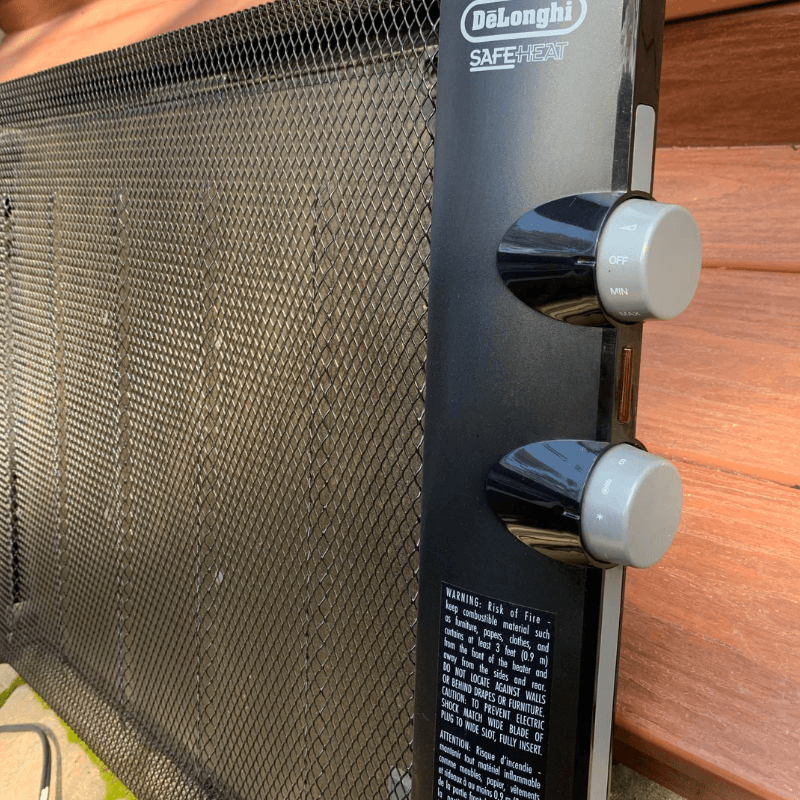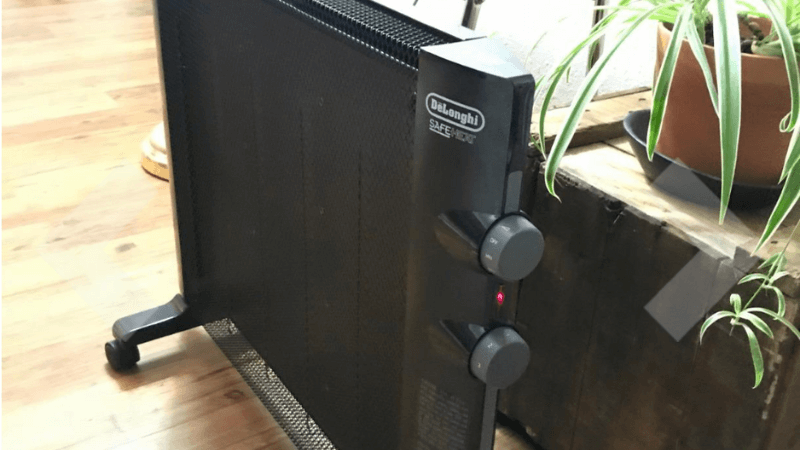Keeping your home warm during the colder months is essential for a comfortable home. You can use different types of heaters, from infrared, oil-filled, ceramic, propane, and micathermic heaters. In this article, we’ll look at micathermic heaters, how they work, their pros and cons, and a comparison to other space heaters. You can also check out our best micathermic heaters.
What is a Micathermic Heater?
A micathermic heater, or mica heater, is a type of space heater that uses Mica, a rock sandwiched around non-metallic heating elements in its design. Micathermic space heaters are considered a crossbreed of infrared and ceramic space heaters because they emit convective and radiant heat.
Instead of relying on one method for heating, a Micathermic heater combines two. Mica heaters produce heat by combining convection and radiant heating methods, making them more efficient than other electric heaters. The mineral Mica is the main reason why Micathermic heaters are highly efficient.
Micathermic heaters also use fanless technology, which distributes heat to a room without re-circulating dust or other allergens. This makes the heater great for people who have asthma and other allergies. The fanless design also means they are quieter than different space heaters.
How a Micathermic Heater Works
When you turn the electricity on, an electric resistor in the Micathermic heater turns it into heat. The heating mechanism of a micathermic heater is similar to that of a convection heater. However, unlike convection heaters, the heating elements of a micathermic heater are covered with Mica.
The mica mineral is of the main reasons micathermic heaters are so effective. Mica generates electromagnetic rays when heated to a certain temperature. The electromagnetic rays heat a room with a similar effect to sunlight. This leaves a soothing heat effect, just like infrared heaters.
When the objects in the room are warmed up, they transfer the heat to the room and the air. However, unlike radiant heaters, Micathermic heaters heat all objects in a room simultaneously. The air warms up quickly because the objects in a room are heated once. This is also why Micathermic heaters heat cold air without using a fan to blow heated air around the room.
Pros of Micathermic Heaters
Evenly Distribute Heat
There are differences in how heaters distribute energy in a room. The Micathermic heater exhibits several differences when compared to the typical heaters. The Mica emits electromagnetic radiation, thereby heating all surrounding objects simultaneously. This makes the room warmer at a relatively higher rate as the switch automatically shuts itself off when the right and desired temperature has been attained. This implies that the Micathermic heater needs less time to serve the same purpose and utilizes less electricity efficiently.
Heat a Room Quickly
The two main heat transfer modes in space heaters are convection and radiation. Convection heaters use convection currents to heat a room. Warm air rises and displaces cold air to the bottom, where it comes into contact with the heater and warms up. Radiant heaters emit infrared heat absorbed by objects and people in a room. Infrared heating is faster than convection heating, but the further you are from the infrared heater, the less you will feel its effects.
Micathermic heaters use electromagnetic rays to heat a room. Their heating methods combine convection and infrared heating faster and more effectively. Micathermic heaters heat objects first at an equal rate, and the objects heat the air simultaneously. This heats the room more quickly than other methods.
Quiet Operation
Noise is one of the biggest complaints raised by many people when it comes to the use of traditional healers. The heaters blow warm air around the room, accompanied by a fair bit of noise. This is because they are installed with fans that aid them in distributing the heat. Micathermic heaters work entirely silently because they do not contain moving parts.
Economical To Operate
Micathermic and other electric heaters use the same power to heat a room. So, a 2000W electric heater will do the same job as a 2000W Micathermic heater in a room. However, Micathermic panel heaters heat quickly and can make a difference in minutes. Because they quickly heat a room, they are energy efficient. The ratio of electricity used and heat produced is also very low. The addition of a thermostat makes them even better.
Safer Than Other Heaters
Convection and radiant heaters pose fire risks by using strong heating sources. This is why convection and radiant heaters must be kept a little far from other objects. In Micathermic heaters, the heated Mica is not as hot as in regular heaters. Heat transfer by electromagnetic rays is safer than other heat transfer systems.

No Ambient Air Movement
In most cases, the traditional heaters blow air around, which possibly causes bacteria and allergens to move around the room. Micathermic heaters use electromagnetic rays to distribute heat around a room. The lack of a fan makes sure they do not blow air containing bacteria and other allergens that might affect asthma and allergy sufferers.
Cons of Micathermic Heaters
Limited Coverage Area
One of the downsides of owning a micathermic heater is the coverage area. Because of the quiet fanless mechanism, micathermic heaters are limited by how large a room they will heat up. Mica heaters will take longer to heat larger spaces, while smaller rooms will get heated quickly.
Most micathermic heaters can easily cover an area of 150 square ft, while some, like the Bionaire models, can heat larger rooms to 200 square ft.
Micathermic vs. Infrared Heaters
Infrared heaters are similar in working mechanisms, just like micathermic heaters. They emit infrared radiation that warms objects instead of heating the air. This gives them a natural feel just as sunlight warms up objects. Although both types of heaters are efficient, infrared heaters are slightly more efficient because they heat objects as opposed to heating the room. However, micathermic heaters will heat a room faster and more evenly than infrared heaters.

